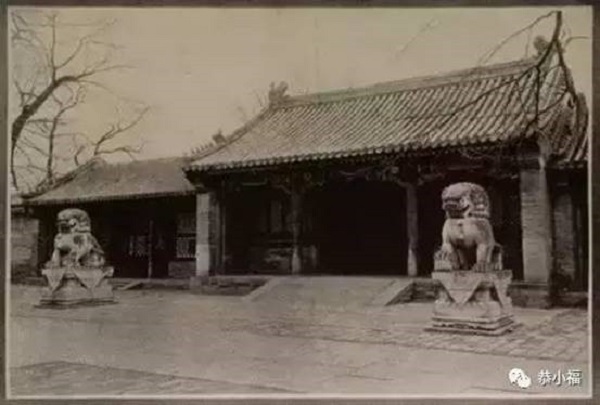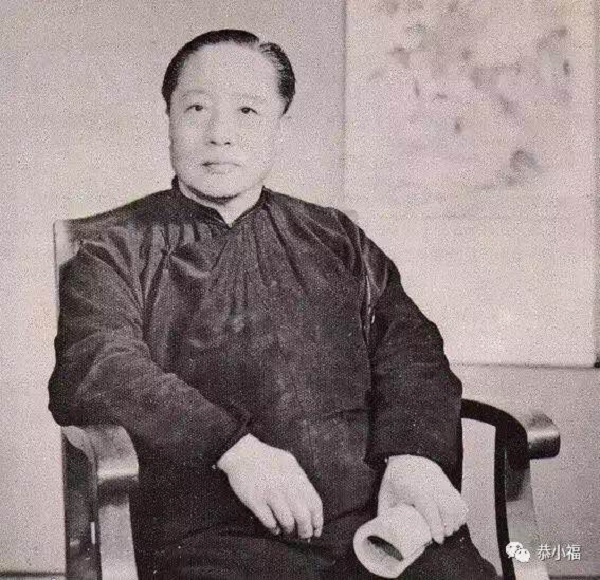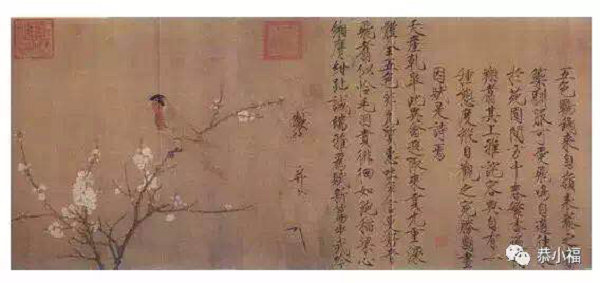
Prince Kung's Palace, located in Beijing, was built in the late Emperor Qianlong reign (r. 1736-1795). It was built by powerful Qing Dynasty (1644-1911) minister Heshen (1750-1799) on the order of Qianlong. It was the residence of the emperor's 10th princess and his husband Fengshen Yinde, who was Heshen's son.
On Feb 7, 1799, the third day after the death of Qianlong, Heshen was convicted of 20 major crimes. On Feb 20, Emperor Jiaqing (r. 1796-1820) deprived Heshen of his property, and on Feb 22 he ordered him to commit suicide.
In 1799, Jiaqing gave the mansion to his younger brother Yonglin, Prince Qing of the Second Rank. In 1825, Yonglin died, leaving the mansion to his son.
In 1850, Emperor Daoguang (r. 1821-1850) gave the mansion to his sixth son Yixin, who was known as Prince Kung. On April 22, 1851, Yixin moved into the mansion, which is still called Prince Kung's Palace.

An old photo of Prince Kung's Palace
He built a courtyard on the west of the mansion to store his collections. The main room of the courtyard was called Xijin Studio, which housed The Consoling Letter (Pingfu tie), a calligraphy work by Lu Ji, a great litterateur and calligrapher of the Western Jin Dynasty (265-316). The name of the west wing room where other calligraphy works and paintings were stored was named Er'er Studio, which meant that its collections were no better than The Consoling Letter. The antiques were stored in the east wing room, called Legu Studio.
With the decline of the Qing Dynasty (1644-1911), the princes lost their stable economic sources. In order to maintain the dignity and a luxurious life, almost all princes began to sell collections or even mortgage their mansions. In just 20 years, most collections in Prince Kung's Palace had been sold out.
In 1912, Puwei (1880-1936), of the clan of Prince Kung Yixin, was in a bad financial situation but he was keen to restore the Manchu Qing regime with the support of the Japanese. He urgently needed funds to launch restoration activities, so he sold all the former treasures of Prince Kung’s Palace except for books and paintings to the Japanese antique dealer Yamanaka Sadajiro.

Puwei (1880-1936), the clan of Prince Kung Yixin

Pu Xinyu (1896-1963), of the clan of Prince Kung Yixin
The relics of Prince Kung's Palace include the cultural legacies that Prince Kung collected and the items for daily use in the mansion. They include daily necessities, practical works of art and decorations. At present, the cultural relics found mainly include furniture, calligraphy, paintings and antiques.
Furniture
There are two major clues for ancient furniture in Prince Kung's Palace. The article Qing Dynasty Royal Furniture states that "a batch of red sandalwood carved furniture from Prince Kung's Palace in the Qing Dynasty was bought from Soochow University, including 20 items and 33 pieces, which boast gorgeous, beautiful and exquisite carvings. They are worthy of being used in the prince's mansion."
This batch of furniture was obtained by the members of the Committee for the Disposition of the Qing Imperial Possessions during the period of the Republic of China. It was brought from Beijing to Shanghai, then to Hong Kong, and finally transferred to Taiwan. It was collected by Soochow University in Taiwan, and finally acquired by the Taipei Palace Museum.

Red sandalwood furniture of Prince Kung's Palace, collected in the Taipei Palace Museum

A red sandalwood armchair with five screens and bat patterns of Prince Kung's Palace, collected in Taipei Palace Museum
There is some Prince Kung's Palace furniture on display in Jietai Temple in Beijing.
During the reign of Emperors Tongzhi and Guangxu (1862-1908), Yixin (the first Prince Kung) invested a large amount of money in Jietai Temple for the construction of Luohan Hall and Peony Hall. In the 10th year of Emperor Guangxu (1884), Yi was dismissed by Empress Dowager Cixi and lived in Peony Hall, where he collected a large number of famous calligraphy and paintings. Until his death, the hall was always his home for self-cultivation.
In 1911, Puwei, the grandson of Yixin, held different political views than Yuan Shikai, the interim president. In 1912, Yuan secretly ordered the arrest of Puwei, who fled to the German concession in Qingdao. His younger brother Pu Xinyu fled with his mother and fourth younger brother to Xi'erqi village, a suburb of Beijing.
Later, the abbot invited them to live in Jietai Temple, where they lived until 1925. Therefore, the furniture used by Prince Kung was preserved in Jietai Temple. This batch of furniture is mostly made of redwood. At present, there are still 64 pieces, including tables, chairs, benches and Duobao cabinets, a cabinet for displaying antiques.

The old furniture of Prince Kung's Palace is displayed in Jietai Temple, Beijing
Calligraphy and Paintings
Clues about the collection of calligraphy and paintings in Prince Kung's Palace mainly come from the autobiography of Yixin's grandson, Pu Xinyu, records of antiquers in the period of the Republic of China and research done by certain scholars.
Many famous calligraphy and paintings have been kept in Prince Kung's Palace, such as Lu Ji's Consoling Letter (Pingfu tie), Wang Xizhi's Youmu Letter (outline and fill-in copy), and Wang Xianzhi's Equn Letter (outline and fill-in copy).

Lu Ji's Consoling Letter (Pingfu tie) of the Western Jin Dynasty (265-316)
The Consoling Letter (Pingfu tie) is the earliest preserved calligraphy masterpiece of the Western Jin Dynasty (265-316). In the sixth year of Emperor Guangxu (1880), Prince Kung got it from Zaizhi and later passed it to Pu Xinyu. In 1937, Pu sold The Consoling Letter (Pingfu tie) calligraphy to Zhang Boju to relieve his financial difficulties. In 1956, Zhang donated The Consoling Letter (Pingfu tie) to the Palace Museum in Beijing.

Han Gan's Night-shining White painting of the Tang Dynasty (618-907)
At that time, Pu Xinyu handed the Night-shining White painting to a British collector. In the following years, this famous Chinese painting of the Tang Dynasty was finally collected in the Metropolitan Museum of Art of the United States.
Gaoshen Manuscript by Yan Zhenqing of the Tang Dynasty
It was mortgaged by Puwei to Mitsubishi Corporation of Japan. In 1930, Japanese calligrapher Nakamura Fusetsu bought it and it is now collected in the Calligraphy Museum in Tokyo, Japan.

Five-Colored Parakeet on a Blossoming Apricot Tree painting by Zhao Ji, Emperor Huizong (r. 1100-1126) of the Song Dynasty (960-1279)
It was lost during the Xinhai Revolution and later purchased by Japanese collector Teijiro Yamamoto and is now collected in the Museum of Fine Arts in Boston, the United States.
Youmu Letter by Wang Xizhi of the Western Jin Dynasty
It was taken out of the mansion around 1900 and sent to Hiroshima, Japan after the Xinhai Revolution. It was reduced to ashes by an atomic bomb in 1945. Today, only copies are available.
Antiques
At the end of the 19th century, Yamanaka & Co. began to collect and sell antiques in China. In addition to acquiring Chinese cultural relics in Beijing's Liulichang, it also established close relations with the royal mansions as another source.
In 1912, Yamanaka bought all the bronzes, ceramics, jades, ancient clocks and other collectibles of Prince Kung's Palace except for calligraphy and paintings from Puwei. This laid a solid foundation for Yamanaka & Co. to become the world's largest dealer of Chinese antiques and cultural relics.
The cultural relics were transported to Japan for sorting, and were divided into three batches: one was shipped to the United States for auction, another was transported to the United Kingdom for auction, and the third was left in the antique stores of Yamanaka & Co. in Japan for retail sale.

Art galleries of Prince Kung's collection in New York, the United States
The collection was made into a beautifully printed blue hardcover book with the words "AAA Prince Kung Collection, New York auction, 1913" on the cover. A total of 536 cultural relics are included in the catalogue, each with a name, time and a short description. Photos of most of them are included.
Among all the cultural relics, the jades have the largest number, at 244 pieces, mainly from the Qing Dynasty but with some from the Han Dynasty (206 BC-AD 220). Although these jades were from early periods, they had good quality, large volume, wide variety and high artistic value.

Jade pen holder of the Prince Kung collection; auctioned in New York in 1913

Red sandalwood round screen made by the order of Emperor Qianlong (r. 1736-1795) of the Prince Kung collection; auctioned in New York in 1913
There are 134 pieces of porcelain, including Guan wares, Ding wares and Jun wares of the Northern Song Dynasty (960-1127), Longquan wares of the Southern Song Dynasty (1127-1279), Dehua wares of the Ming Dynasty (1368-1644) and Jingdezhen products for imperial use of the Qing Dynasty (1644-1911).
The utensils include pots, bowls, plates, Buddha statues, bottles, cans, boxes, etc. The glaze colors include blue and white, monochrome glaze, and shadow green.

A bronze ware of the Prince Kung collection; auctioned in New York in 1913
There are 99 bronze pieces, including common utensils such as zun, jue, gui and ding, as well as some animal-shaped zuns (a kind of drinking set) and wine pots with strange shapes.
In addition, there are 11 ivory and rhinoceros horn products and other ritual utensils such as fabrics and portraits.
In a word, these collections have high historical and artistic value, and are comparable to the imperial ones.